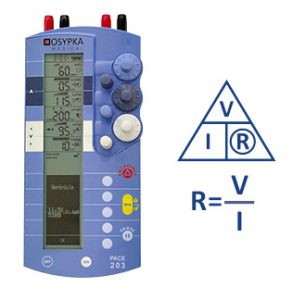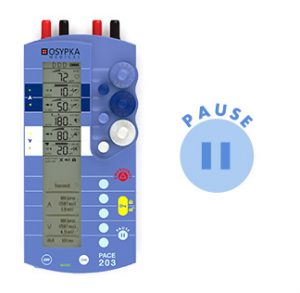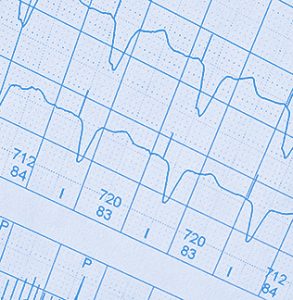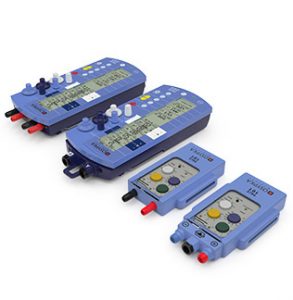Key Features
Temporary Pacemaker
Safe and effective operation of a temporary pacemaker can be challenging. We came up with some unique features which will make your life much easier – and you comfortable using a temporary pacemaker.
|
PACE® Model 101
|
PACE® Model 203
|
PACE® Model 300
|
|
| Pacemaker Type | Single Chamber (SSS) |
Dual Chamber
(DDD)
|
Triple Chamber (DDD BV, CRT) |
| Pacing Modes | VVI, AAI, V00, A00 | DDD (RV, LV), VVI (RV, LV), AAI, VDD (RV, LV), D00 (RV, LV), V00 (RV, LV), A00, DVI (RV, LV), DAI (RV, LV), VAT (RV, LV), AAT, DDD+AT (RV, LV), DAT (RV, LV), DDI (RV, LV) | DDD (BV, RV, LV), VVI (BV, RV, LV), AAI, VDD (BV, RV, LV), D00 (BV, RV, LV), V00 (BV, RV, LV), A00, DVI (BV, RV, LV), DAI (BV, RV, LV), VAT (BV, RV, LV), AAT, DDD+AT (BV, RV, LV), DAT (BV, RV, LV), DDI (BV, RV, LV) |
| Basic Rate | 30 – 180 ppm |
30 – 220 ppm
|
30 – 220 ppm |
| Rapid Pacing / Overdrive Pacing | Basic Rate x2 or x4 (up to 720 ppm) |
Atrial up to 1000 ppm
Ventricular up to 220 ppm |
Atrial up to 1000 ppm |
| Stimulation Amplitude | 0.3 – 12 V | 0.1 – 18 V | 0.1 – 18 V |
| Pulse Width | 0.75 ms | 0.05 – 1.5 ms | 0.05 – 1.5 ms |
| Sensitivity | 1.0 – 20 mV, Asynchronous | Atrial: 0.2 – 20 mV, Asynchronous
Ventricular: 1.0 – 20 mV, Asynchronous |
Atrial: 0.2 – 20 mV, Asynchronous
Ventricular: 1.0 – 20 mV, Asynchronous |
| Refractory Period | 250 ms | Atrial: 250 ms
Ventricular: 250 ms |
Atrial: 250 ms
Ventricular: 250 ms |
| Impedance Display | |||
| Autosense Function | |||
| Measurement of Intrinsic Signals | |||
| Pacing Statistics | |||
| Terminal Versions | Version 1: Collets for unipolar exposed pins (Ø0.3 … 2.0 mm) or Osypka adapters.
Version 2: Socket for bipolar connector and sockets for unipolar touch-protected (“shrouded”) 2 mm pins |
Version 1: Collets for unipolar exposed pins (Ø 0.3 … 2.0 mm) or Osypka adapters.
Version 2: Sockets for bipolar connectors (A and V) |
Collets for unipolar exposed pins (Ø 0.3 … 2.0 mm) or Osypka adapters. |
| Battery Lifetime | Up to 38 days | Up to 10 days | Up to 4 days |
| Dimensions (L x W x H) | 60 mm x 115 mm x 22 mm | 212 mm x 96 mm x 51 mm | 212 mm x 96 mm x 51 mm |
| Weight | 170 g (0.375 lb) including battery | 490 g (1.08 lb) including battery | 490 g (1.08 lb) including battery |
Key Features explained
Impedance (PACE® Model 203 & 300)
 Next to a reasonable low capture threshold (for stimulation) and reasonable high measured P/R wave amplitudes (for sensing), impedance is the third component establishing a quality check of your stimulation setup.
Next to a reasonable low capture threshold (for stimulation) and reasonable high measured P/R wave amplitudes (for sensing), impedance is the third component establishing a quality check of your stimulation setup.
Like many things in life (think about your blood pressure!), impedance should be smack in the middle, that is, within the load range of the temporary pacemaker (usually 200 … 1,200 Ohms, applicable for any brand).
An impedance less than 200 Ohms requires a high stimulation current (mA!) to maintain an adequate stimulation voltage. Pacing wires (uniploar or bifurcated) not touching each other but placed in proximity may cause such a low impedance – while you wonder why you cannot get capture even at maximum stimulation output.
An impedance which exceeds the upper end of the load range is indicative of problematic connections.
Upon turning the atrial or ventricular output dial by an increment, a pop-up window will indicate you the impedance of the atrial or ventricular stimulation circuit (PACE® Model 203 only). Conveniently, applied voltage output and calculated output current (mA) are displayed, too. This works also when the device is locked!
With the PACE® Model 300, the impedance display for all three circuits (A, LV, RV) can be called up in the submenu.
Auto Sense (PACE® Model 203 & 300)
Auto Sense is a convenient feature adapted from the world of implantable pacemakers. Each time intrinsic events cause the pacemaker to inhibit, the pacemaker is automatically (“Auto”) measuring P wave amplitudes in the atrium and R wave amplitudes in the ventricle. Based on these results, the pacemaker continuously monitors and, if needed, properly adjusts, the sensing thresholds.
Wouldn’t you be much more comfortable knowing that the pacemaker is not only determining the initial sensing thresholds but also monitoring these over time – hours, days!
Pause Function (PACE® Model 203 & 300)
 Traditionally, the Pause Function serves for temporary interruption of pacing therapy, allowing to view the patient’s intrinsic rhythm on an ECG monitor.
Traditionally, the Pause Function serves for temporary interruption of pacing therapy, allowing to view the patient’s intrinsic rhythm on an ECG monitor.
While the PAUSE key is pressed, PACE® Model 203 & 300 measure atrial P Wave amplitude and rate, ventricular R Wave amplitude and rate, as well as the intrinsic atrio-ventricular (AV) interval.
This information may be used to adjust atrial and ventricular sensing thresholds as well as the setting of the pacemaker’s AV Delay.
Considering how cumbersome the manual determination of P/R Wave amplitudes in AV sequential pacing is, this feature – unique in temporary pacing – increases the comfort level of the user operating a temporary pacemaker.
Statistics (PACE® Model 203)
 During pacing therapy, the pacemaker is counting the number of intrinsic events, stimulated events, extrasystoles and cardiac cycles subject to artifact or interferences.
During pacing therapy, the pacemaker is counting the number of intrinsic events, stimulated events, extrasystoles and cardiac cycles subject to artifact or interferences.
The statistics feature provides a retrospective overview about the pacing therapy, helping to determine to which degree the patient’s rhythm relied on pacing therapy.
Terminal Versions
 With respect to the terminals which connect to extension cables and pacing leads, our temporary pacemakers PACE® Model 203 and PACE® Model 101 come in two different “flavors”.
With respect to the terminals which connect to extension cables and pacing leads, our temporary pacemakers PACE® Model 203 and PACE® Model 101 come in two different “flavors”.
One version of terminals is providing unipolar collets which adapt to pins with a diameter between 0.3 … 2.0 mm. These collets work well when connecting pacing wires directly to the pacemaker.
Another version is providing bipolar sockets which adapt to specific extension cables. Quick and easy connection and disconnection and touch-protection are the main advantages of this version of terminals.
The PACE® Model 101 version with bipolar terminals provides additional unipolar sockets for touch-protected (“shrouded”) pins, allowing direct connection of almost any temporary transvenous pacing lead. This feature becomes handy in situations when an extension cable is not readily available.
DDD-BV (PACE® Model 300)
Two separate pacing and sensing channels for the right and left ventricle distinguish the AV sequential, bi-ventricular PACE® Model 300 from any other temporary pacemaker.
With applications such as cardiac resynchronization (CRT) or complex congenital heart diseases in mind, PACE® Model 300 allows the establishment of a delay between right and left-ventricular stimulation as well as the order of ventricular stimulation (RV first or LV first).
Rapid Pacing and Atrial Overdrive Pacing
All PACE® Models provide a function for rapid atrial pacing, although known as atrial overdrive pacing or atrial high pacing as a therapy option for terminating atrial flutter.
In addition, PACE® Model 203 provides a function for rapid ventricular pacing up to 220 ppm. This feature allows quick changes between a basic rate and a higher ventricular pacing rate.
Battery Lifetime
Efficient design of our pacemakers leads to industry-leading battery lifetimes – without any compromises towards safety and efficacy.
On a single battery charge, PACE® Model 101 continuously stimulates for about 38 days.
PACE® Models 203 and 300 allow replacement of a battery during pacing therapy. After at least an hour of operation – allowing the internal backup capacitors to charge – PACE® Models 203 and 300 “bridge” a battery swap for at least 30 seconds.
